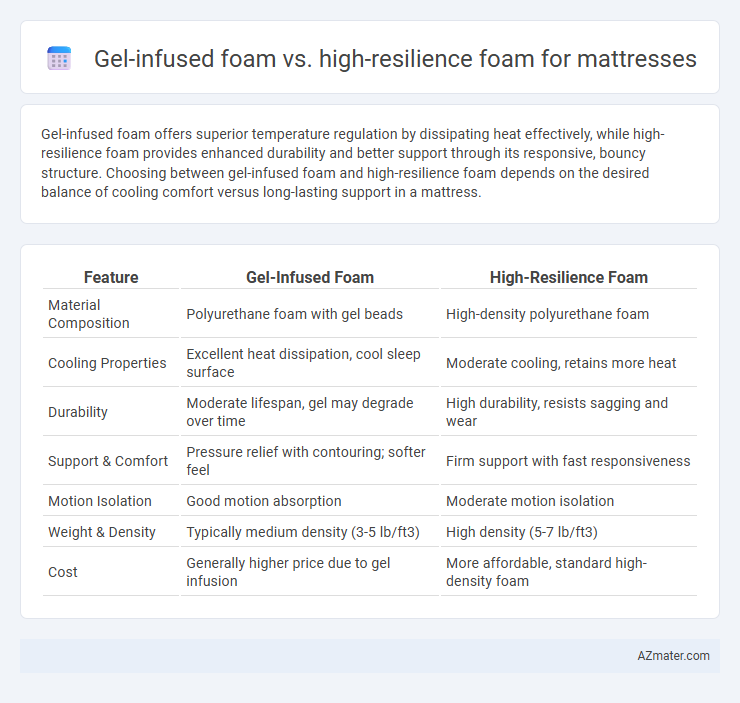Gel-infused foam offers superior temperature regulation by dissipating heat effectively, while high-resilience foam provides enhanced durability and better support through its responsive, bouncy structure. Choosing between gel-infused foam and high-resilience foam depends on the desired balance of cooling comfort versus long-lasting support in a mattress.
Table of Comparison
| Feature | Gel-Infused Foam | High-Resilience Foam |
|---|---|---|
| Material Composition | Polyurethane foam with gel beads | High-density polyurethane foam |
| Cooling Properties | Excellent heat dissipation, cool sleep surface | Moderate cooling, retains more heat |
| Durability | Moderate lifespan, gel may degrade over time | High durability, resists sagging and wear |
| Support & Comfort | Pressure relief with contouring; softer feel | Firm support with fast responsiveness |
| Motion Isolation | Good motion absorption | Moderate motion isolation |
| Weight & Density | Typically medium density (3-5 lb/ft3) | High density (5-7 lb/ft3) |
| Cost | Generally higher price due to gel infusion | More affordable, standard high-density foam |
Introduction to Mattress Foam Technologies
Gel-infused foam integrates cooling gel particles to enhance temperature regulation and improve sleep comfort by dissipating heat more effectively than traditional foams. High-resilience foam is engineered with a more responsive and durable structure, providing superior support and longevity by quickly adapting to the body's movements. Both foam technologies are essential innovations in mattress design, targeting improved comfort, pressure relief, and durability.
What is Gel-Infused Foam?
Gel-infused foam is a type of memory foam that incorporates gel beads or gel swirls to enhance heat dissipation and maintain a cooler sleeping surface. This gel technology improves airflow within the mattress, reducing heat retention often associated with traditional memory foam. Compared to high-resilience foam, gel-infused foam offers superior temperature regulation and pressure relief, making it a preferred choice for sleepers prone to overheating.
What is High-Resilience (HR) Foam?
High-Resilience (HR) foam is a type of polyurethane foam known for its superior durability, elasticity, and supportive qualities, making it ideal for mattresses that require long-lasting comfort and resilience. It features an open-cell structure that promotes better airflow and pressure distribution compared to traditional foam types. Gel-infused foam, by contrast, incorporates cooling gel beads to regulate temperature but often lacks the same level of bounce and structural support found in HR foam.
Temperature Regulation: Gel-Infused vs. HR Foam
Gel-infused foam mattresses excel in temperature regulation by incorporating cooling gel beads that dissipate heat and enhance airflow, preventing overheating during sleep. High-resilience (HR) foam provides robust support and durability but tends to retain more heat due to its dense cellular structure and limited breathability. Choosing gel-infused foam significantly improves thermal comfort, especially for individuals sensitive to night sweats or warmer climates.
Support and Pressure Relief Comparison
Gel-infused foam offers enhanced pressure relief by distributing body weight evenly and reducing heat retention for cooler sleep, making it ideal for sensitive pressure points. High-resilience foam provides superior support due to its denser, more responsive structure, promoting better spinal alignment and durability over time. Both materials balance comfort and support, but gel-infused foam excels in pressure alleviation while high-resilience foam delivers more consistent, long-lasting support.
Durability and Lifespan: Which Lasts Longer?
Gel-infused foam offers enhanced cooling properties but generally has a shorter lifespan due to its softer structure, typically lasting around 5 to 7 years. High-resilience foam is denser and engineered for durability, providing superior support and maintaining shape for 7 to 10 years or more. For longevity and consistent performance, high-resilience foam mattresses outperform gel-infused foam in durability and lifespan.
Motion Isolation Capabilities
Gel-infused foam mattresses excel in motion isolation by absorbing and dissipating movement, which reduces motion transfer and enhances sleep quality for couples. High-resilience foam also provides strong motion isolation due to its responsive and durable structure, but it may allow slightly more motion transfer compared to gel-infused foam. For optimal motion isolation, gel-infused foam is often preferred in mattresses due to its superior ability to minimize sleep disturbances from partner movements.
Comfort and Sleeping Experience
Gel-infused foam mattresses excel in temperature regulation by dispersing heat, providing a cooler sleeping surface ideal for hot sleepers. High-resilience foam offers superior responsiveness and durability, maintaining support and shape over time for consistent comfort. The choice depends on prioritizing cooling benefits or long-lasting support to optimize the sleeping experience.
Ideal Sleepers for Each Foam Type
Gel-infused foam offers excellent temperature regulation and pressure relief, making it ideal for hot sleepers and those with joint pain or sensitive pressure points. High-resilience foam provides strong support and durability, best suited for heavier individuals and back sleepers who need firm spinal alignment and bounce. Both foams cater to different sleep preferences, optimizing comfort based on body weight, sleep position, and heat sensitivity.
Cost Considerations and Value for Money
Gel-infused foam mattresses typically cost more due to advanced cooling properties and enhanced breathability compared to high-resilience foam, which offers durable support at a lower price. High-resilience foam provides a budget-friendly option with excellent resilience and longevity, making it ideal for consumers prioritizing cost-effectiveness. Evaluating the balance between upfront price and long-term comfort benefits helps determine the best value for money in mattress selection.

Infographic: Gel-infused foam vs High-resilience foam for Mattress
 azmater.com
azmater.com